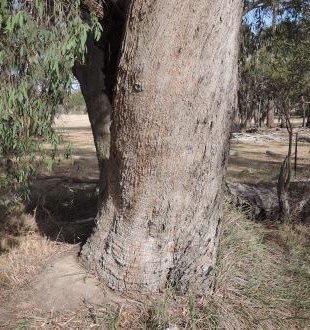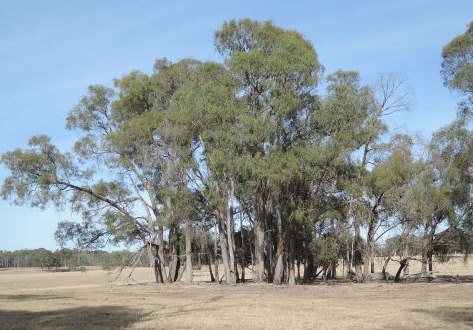scale bar = 1cm.
Narrow-leaved Peppermint - native (Eucalyptus radiata)
Home....
Menu....
Common name index....
Scientific name index....
Glossary....
Other eucalypts....
Juvenile leaves
Narrow-leaved Peppermint is common in wetter forests e.g. near Daylesford and Trentham. It grows in the Faraday-Elphinstone districts. It can grow to a large, tall tree.
Recognise Narrow-leaved Peppermint by:
- the finely fibrous bark (similar to that of box eucalypts).
- the narrow (less than 2cm wide), paired, tapering juvenile leaves
- the numerous oil dots in the leaves. The leaves have a strong eucalyptus smell if crushed.
- the radiating clusters of buds and fruit (hence the scientific name radiata).
The juvenile leaves of Narrow-leaf Peppermint resemble those of Manna Gums. Peppermint leaves have more oil-dots and are more strongly scented than those of Manna Gums.
Some forms of Broad-leaved Peppermint have (despite the common name) narrow leaves. The buds and fruit of Broad-leaved Peppermint are larger than those of Narrow-leaveed Peppermint, the juvenile leaves are much broader (3cm or more), and the trees are usually less tall.



1: Juvenile leaves are narrow, and in opposite, stalkless pairs. Enfield. 2: Trunk with finely-fibrous bark. Faraday.
3: Narrow-leaved Peppermint. Wombat Forest. In damp conditions, lichen on the trunks is common.


4: Narrow-leaved Peppermint copse. Faraday. 5: Peppermint forest in mist. Wombat Forest.


6: Roadside tree. Pollards Road. 7. Narrow-leaved Peppermint. Burgoynes Road, Faraday.


4: Narrow-leaved Peppermint copse. Faraday. 5: Peppermint forest in mist. Wombat Forest.


6: Roadside tree. Pollards Road. 7. Narrow-leaved Peppermint. Burgoynes Road, Faraday.